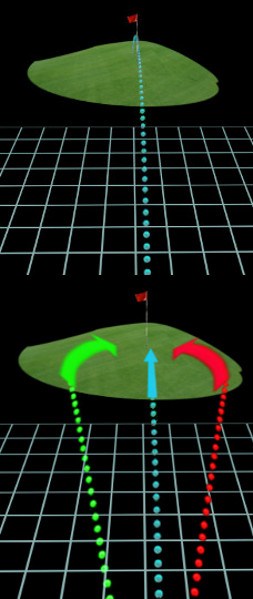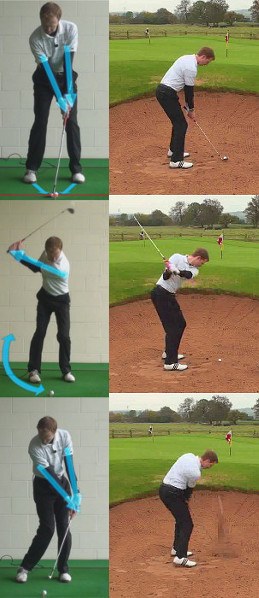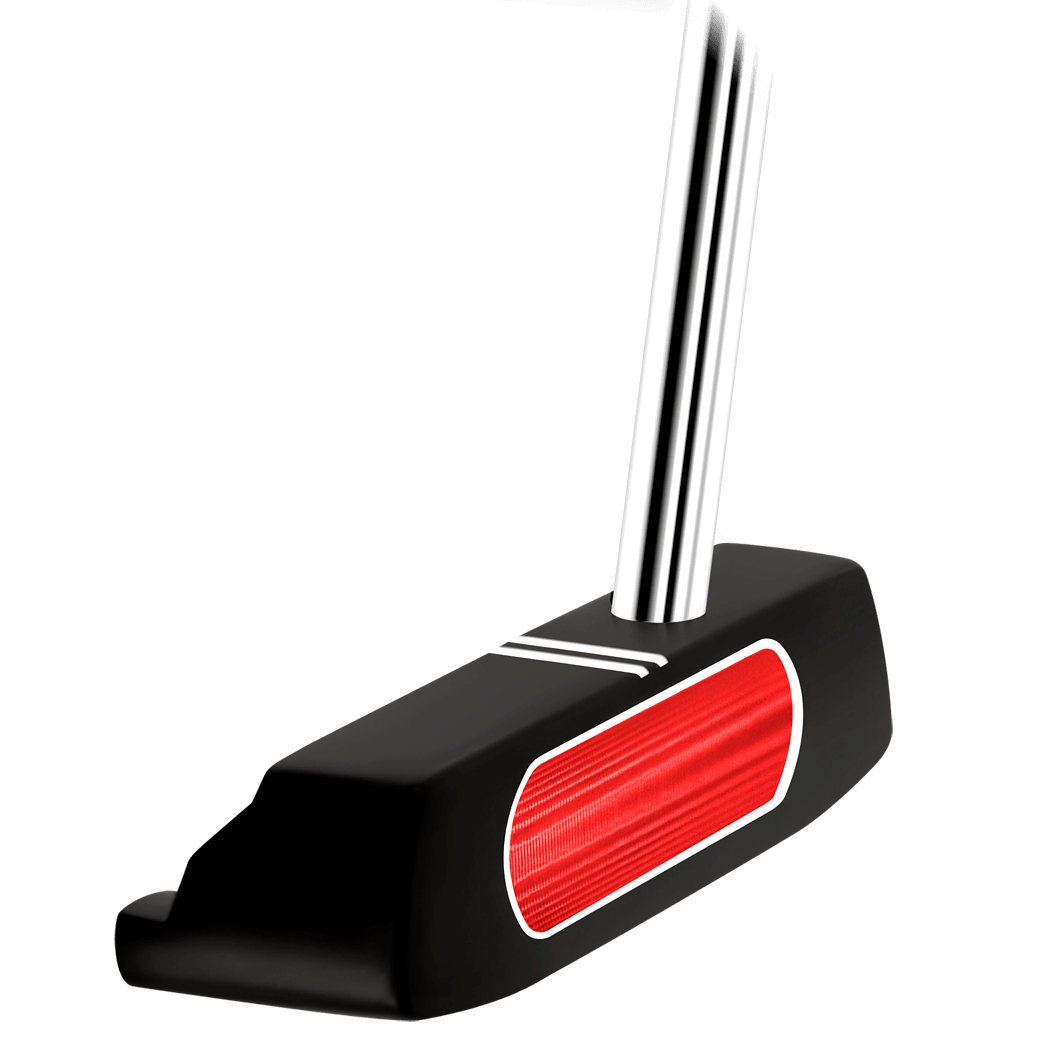
The short game isn't so complicated. You hit the ball toward the hole until it goes in, right?
If only it were that simple.
Chipping, pitching and bunker play require such short swings and cover so little ground, you'd think getting the ball close to the hole would be pretty straightforward. Indeed, aside from factoring in a bit of break in the green, most golfers play these shots in a very direct manner.
While that's often the best approach, sometimes you need a little imagination to pull off a great short shot.
The ability to visualize different ways of playing a chip or pitch is especially useful when the greens are very undulating or fast. In these cases, a minor mistake can send your ball skittering far from the hole. On the other hand, a shot that looks terrifying on first glance might offer a lower-risk alternate route.
Playing with imagination means keeping your eyes (and mind) open to all options, not just the one lying on a straight line from your ball to the cup. These tips should help you see more possibilities around the greens:
Take a wide-angle view
Ironically, many golfers find executing a straight chip more difficult than one with break. If you're such a golfer, look to either side of the direct line when faced with a straight shot. You may find a slope that will kick your ball toward the hole.
Likewise, don't limit your read to the area between you and the cup. There may be a steep hump or “backstop” behind the hole. If the green is slick, play the shot to roll onto the slope, then watch it trickle back toward the hole. This requires less precision than trying to cozy the ball up to the flag.
Eliminate the break
On the greens, sometimes your best bet is to “take the break out of” a putt. In other words, to hit the ball firmly on a more direct line, reducing the amount it will curve. A similar concept applies from off the green. But instead of hitting the ball harder, you hit it higher and father.
Here's an example. You've got 50 feet to the hole, uphill all the way, and a good lie. For the first 30 feet, the green tilts to the left. The final portion, including the hole location, is flat. Your basic choices are:
1. A chip-and-run aimed right of the hole to account for the break, meaning you must judge both the line and speed correctly; or
2. A pitch shot that flies past the sloped section, lands on the flat part and stops quickly. This removes a major variable, the break, requiring only that you hit the shot the right distance.
Around the greens, a little imagination can help you simplify this complicated game.

How to Use Your Imagination Around the Greens
One of the best things about golf is the fact that it gives players a chance to be creative. It is easy to take this aspect of the game for granted, but if you really think about what makes golf fun, creativity has a lot to do with it. You have tremendous freedom in choosing how you play each shot, as long as you stay within the defined rules of the game. Want to play the ball high in the air? Go for it. Want to hit a shot that bounces along the ground? No problem. There is more room for creativity in golf than in just about any other recreational sport.
It is the idea of creativity that is going to be the topic for this article. Specifically, we are going to talk about using your imagination in the short game. When your ball comes to rest near the green, but not on it, you have a significant number of options at your disposal. There are nearly as many different short game shots as there are golfers. Rather than feeling like you have to hit one or two specific kinds of shots for the majority of your short game play, you should feel free to let your imagination run wild.
Of course, it can be a bit tricky to teach the concept of using your imagination. If we told you exactly what kinds of shots to hit, and when to hit them, you really wouldn't be putting your own creativity to use. So, we aren't going to do that. Instead, we are going to give you some ideas, and it will be up to you to use those ideas as you see fit. We'll introduce a few different ways of thinking about the short game, and we will discuss some basic shots that you'll want to have in your repertoire. From there, your job is to get out onto the short game practice area at your local course to work on your skills. Once you have built up a variety of short game shots that you trust, it will be easy to let your imagination take over on the course.
It is important to remember that you should be having fun with your game while working to learn new shots. Having the opportunity to be creative around the greens is one of the most rewarding parts of being a golfer. You won't have many better experiences on the course than the thrill of using some type of creative shot to get the ball up and down from a tough spot. Sure, it might be fun to launch a 300-yard drive down the middle of the fairway, but it is the brilliant little chip shots that you will remember for years to come.
All of the content below is based on a right-handed golfer. If you happen to play left-handed, please take a moment to reverse the directions as necessary.

Seeing All the Options
In order to use your imagination to the fullest extent around the greens, you need to avoid developing tunnel vision. In other words, you need to approach the short game with an open mind, willing to consider a variety of options before settling on a winner. This is not the way most amateur golfers go about their business. Instead, the average player walks up to find his or her ball near the green, settles on the first type of shot that comes to mind, and swings away. Rushing to make this kind of decision is sure to lead to less-than-ideal results. By adding some patience to the process and considering all the options at hand, you're far more likely to arrive at the best possible conclusion.
The list below highlights a few of the options that you may have available to you on a given chip or pitch shot. Of course, all of these options will not be present on every shot, so it will be up to you to spot the opportunities you have been given by the course.
- Play the ball high in the air. For many amateur golfers, this is the first shot that comes to mind when around the greens. Using a lofted wedge, you can lob the ball up into the air and bring it down softly – hopefully somewhere near the hole. This type of shot has its pros and cons. On the positive side, the ball isn't going to move much after it lands, meaning you can take aim at the hole in most cases. However, it can be hard to strike these kinds of shots cleanly, and it can be tough to control your distance properly. It takes a steady hand and plenty of practice to pull off high short game shots with consistency.
- Play the ball along the ground. In reality, this is the shot that amateur golfers should default to using whenever possible. Playing your chip shots along the ground is the easiest way to go, as this option gives you margin for error at the moment of impact. Even if you don't make perfect contact, you can still get away with a decent result in most cases. Also, a low chip shot can be played successfully from a variety of lies. If you are early in your golf career and just beginning to build your short game, focus on this shot first and then expand as your confidence grows.
- Use a slope. Rarely will you come across a putting green that is perfectly flat. They are almost always sloped at least to some degree – and many are sloped quite severely. When playing a course that features dramatic, undulating greens, you can often use those slopes to your advantage. If you don't have a good angle to play your chip or pitch shot directly at the hole, consider using a slope to bring the ball in for a shorter putt. Maybe you can run the ball past the hole and let it trickle back down, or maybe you can play out to the side before letting a slope swing the ball back in. Whatever the case, keep an open mind and think about using the slope of the green to your advantage.
- Use an unorthodox club. When you think about chipping and pitching, you think first about your wedges. And, of course, most of these kinds of shots are going to be played with your wedges. However, there is no rule which states you must use a wedge when hitting a chip shot. For instance, if you have a clean lie and no long grass in your way, you might be able to bump the ball up onto the green with a five iron. Or, you could play a shot from the fringe with a hybrid, letting the ball take a couple of small bounces before rolling out to the cup.
The list above is just a starting point, but you get the idea. When you commit yourself to keeping an open mind, you will be amazed at the various shots you start to see. There are many ways to get the job done in the short game, and the methods that you have been using up to this point might not actually be the best options. Now that you understand the importance of creativity and keeping an open mind, it will be exciting to see what you are able to come up with in your next few rounds.

Having a Standard Collection of Shots
It is great to say that you are going to be more creative in the short game, but you have to actually have the skills to make that happen. If you don't know how to hit more than one type of shot, it is difficult to really let your imagination run wild. For example, if the bump-and-run is the only chip shot you feel comfortable using, it will be nearly impossible to play the ball high in the air. To be able to pull off the shots your creativity uncovers, you have to prepare yourself well in advance of heading out onto the course.
In this section, we are going to identify three basic types of short game shots. If you can learn each of these three shots, you will have a great platform on which to build the rest of your short game. There is nothing particularly complicated about any of these shots, but they will take a little bit of practice to learn how to use effectively. Once you have successfully added all three of these shots to your game, you can then learn how to use variations of these basic shots to create just about any kind of short game shot you can dream up. With a combination of creative thinking and a well-prepared physical game, you will be nearly unstoppable around the greens.
Please take a moment to review these three types of shots below.
- A low chip shot. This shot is often referred to as a 'bump-and-run', but it doesn't really matter what you call it, as long as you know how to play it properly. This kind of chip shot is played low to the ground, with the ball only carrying a few inches through the air before bouncing and rolling toward the hole. The club you will use for a low chip shot depends on the distance you have to the hole, but you can use anything from a long iron on up to a wedge. As far as technique is concerned, you are going to mimic your putting stroke when playing a low chip shot. Keep your hands and wrists quiet as you rock your shoulders back and through to send the ball on its way. When executed properly, this is an extremely simple shot which will provide you with consistent results. Considered by most people to be the easiest of the short game shots, you want to be sure that you are highly confident in your technique for this play.
- A high chip shot. Things get a little trickier when you send the ball high up into the air. For this shot, you are going to use a lofted wedge – often a sand wedge or a lob wedge – and you are going to use much more release in your hands and wrists than on the low chip shot. The key here is to make solid contact, as miss-hitting this kind of shot slightly will lead to ugly results. Place the ball near the front of your stance when you need to elevate the shot, and set up with the face of the club at least slightly open at address. When making the swing, move the club slightly across the ball from outside to inside. You will be tempted to look up early to see where the ball is going, but it is important to resist that temptation. Keep your head down, keep your eyes on the back of the ball, and only look up once you are sure the shot is on its way.
- A blast from the long rough. The last shot on our list is one that you will hope to not use very often. When you leave your ball in the long rough around the green, you may find that neither of the two options above is particularly suitable for the challenge you are facing. When that happens, you are actually going to turn to your bunker technique for assistance. To play this shot, open the face of your most-lofted wedge and make a big swing. You aren't trying to hit the ball cleanly with this shot – instead, you are trying to put the wedge into the grass behind the ball so you can hit an explosion shot, much like you would do from the sand. It should go without saying that this is an unpredictable shot. It's hard to know how far the ball is going to go when you make this kind of swing, but you don't have much of a choice from this position. With any luck, you'll at least be able to blast the ball up onto the putting surface, and you can move on from there.
During your next short game practice session, make it a point to work on each of the three shots listed above. Specifically, spend most of your time working on the first two, as those will be the most valuable to you on the course. As long as you have the ability to hit both low and high chip shots on command, your short game will always be ready to help you save strokes.







